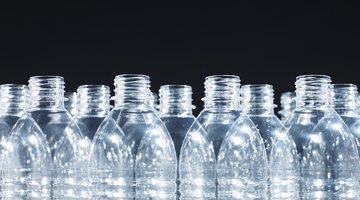SPI Mold Finish Standards
The Society of the Plastics Industry, or SPI, establishes standards for the United States plastics industry. Among the SPI standards is one defining the degree of polish on the inner surfaces of the molds used to form plastic products.

The SPI standards specify 12 grades of mold finish ranging from mirror-perfect to dull. Various companies offer illustrative sample kits consisting of steel discs or strips polished to the different SPI grades.
Shiny Finishes
SPI grades A-1, A-2 and A-3 specify high gloss finishes on hardened tool steel molds buffed to a mirror sheen with fine diamond powder suspended in oil. Plastic parts made to these grades show no mold parting marks or tool or machining marks. An A-1 mold finish has no more than 1 millionth of an inch deviation from perfect. An A-2 finish allows up to 2 millionths of an inch deviation, while an A-3 finish allows deviation of up to 3 millionths of an inch from perfect. These super smooth and shiny finishes are very expensive and time-consuming to achieve. They are specified to make plastic mirrors, visors and other optical plastic goods.
Semi-Gloss Finishes
SPI grades B-1, B-2 and B-3 specify semi-gloss finishes with some sheen, on hardened tool steel molds polished with ultra-fine-grit sandpaper or emery cloth. Again, plastic parts from these molds can’t show mold, tool or machining marks. Grade B-1 allows a 3 millionths of an inch deviation from perfect. Grade B-2 allows up to 5 millionths of an inch deviation, while Grade B-3 allows up to 10 millionths of an inch deviation from perfect.
Matte to Dull
The SPI’s grades C-1, C-2 and C-3 specify matte finishes from steel molds polished with fine stone powder. These finishes can’t show mold, tool or machining marks. Grade C-1 allows up to 12 millionths of an inch deviation from perfect, Grade C-2 allows up to 28 millionths of an inch deviation and Grade C-3 allows up to 42 millionths of an inch deviation. SPI grades D-1, D-2, D-3 specify dull, nonreflective finishes from steel molds sandblasted with glass beads or iron oxide powder. These blasted finishes are used on diecast or thermoset plastic industrial parts. Grade D-1 allows a deviation of up to 12 millionths of an inch from perfect, D-2 allows a deviation of up to 32 millionths of an inch, while Grade D-3 permits up to a 230 millionths of an inch deviation from perfect.
Displaced Standard
The SPI mold finish standards have superseded other finishing standards, but customers sometimes use old finish grades when writing mold specifications. For example, the Society of Plastics Engineers from the 1960s through 1980s offered a scale of 1 to 6 to specify mold finishes ranging from a high-sheen diamond polish to rough blasted surface. The SPI incorporated the SPE grades in its new finishing standards. SPE #1 corresponds to SPI Grade A-1, SPE #2 to SPI A-2, SPE #3 to SPI B-3, SPE #4 to SPI C-3, SPE #5 to SPI D-2 and SPE #6 to SPI D-3.
The Drip Cap
- The Society of the Plastics Industry, or SPI, establishes standards for the United States plastics industry.
- SPI grades A-1, A-2 and A-3 specify high gloss finishes on hardened tool steel molds buffed to a mirror sheen with fine diamond powder suspended in oil.
- These super smooth and shiny finishes are very expensive and time-consuming to achieve.
- Again, plastic parts from these molds can’t show mold, tool or machining marks.
- Grade B-2 allows up to 5 millionths of an inch deviation, while Grade B-3 allows up to 10 millionths of an inch deviation from perfect.
References
Writer Bio
Herb Kirchhoff has more than three decades of hands-on experience as an avid garden hobbyist and home handyman. Since retiring from the news business in 2008, Kirchhoff takes care of a 12-acre rural Michigan lakefront property and applies his experience to his vegetable and flower gardens and home repair and renovation projects.
Photo Credits
- Ryan McVay/Digital Vision/Getty Images
- Ryan McVay/Digital Vision/Getty Images
More Articles



